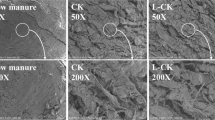Abstract
Dissolved organic carbon (DOC) in drinking water is mainly composed of fulvic and humic acids, which may form complexes with metal ions. The influence of DOC on the intestinal absorption of Cd in the rat was investigated using an “isolated intestinal segment” technique in anaesthetised rats. The lumens of segments were exposed for 60 min to different concentrations of CdCl2 and DOC in intact animals. The fractional absorption (FA) was not dose dependent in the dosage interval 0.01–0.03 μg Cd/kg. However, at 15 and 150 μg Cd/kg both FA and intracellular Cd distribution in the segments were dose dependent, which is in line with results from other studies performed on similar experimental models. In the presence of 1 and 10 mg DOC/1, FA of Cd was just half as high as FA in animals that received Cd alone (0.01 μg/kg). Moreover, a higher percentage of Cd was associated with the metallothionein fraction in the intestinal segment of the DOC-dosed rats. An in vitro speciation experiment showed that only 0.2–7.9% of the Cd in the incubation solution was complexed to DOC. In deionized water, however, more than 99% of the Cd was complexed to DOC. This result indicates that the incubation solution contained substances that negatively affect complexation of Cd to DOC. Mechanisms other than complexation of Cd to DOC in the intestinal lumen may there-fore be involved in the inhibitory effect of DOC on the absorption of Cd.
Similar content being viewed by others
References
Alberts JJ, Filip Z, Hertkorn N (1992) Fulvic and humic acids isolated from groundwater: compositional characteristics and cation binding. J Contam Hydrol 11: 317–330
Andersen O (1989) Oral cadmium exposure in mice: toxicokinetics and efficiency of chelating agents. Crit Rev Toxicol 20: 83–112
Bevan C, Foulkes EC (1989) Interaction of cadmium with brush border membrane vesicles from the rat small intestine. Toxicology 54: 297–309
Buchet JP, Lauwerys R, Roels H, Bernard A, Braux, P, Claeys F, Ducoffre G, de Plaen P, Staessen J, Amery A, Lijnen P, Thijs L, Rondia D, Sartor F, Sain Remy A, Nick L (1990) Renal effects of cadmium body burden of the general population. Lancet 336: 699–702
Driscoll CT, Letterman RD (1988) Chemistry and fate of Al(III) in treated drinking water. J Environ Eng 114: 21–37
Engström B, Nordberg GF (1979) Dose dependence of gastrointestinal absorption and biological half-time of cadmium in mice. Toxicology 13: 215–222
Flaten TP, Bølviken B (1991) Geographical associations between drinking water chemistry and the mortality and morbidity of cancer and other diseases in Norway. Sci Total Environ 102: 75–100
Foulkes EC (1980) Some determinants of intestinal cadmium transport in the rat. J Environ Pathol Toxicol 3: 471–481.
Foulkes EC (1989) On the mechanism of cellular cadmium uptake. Biol Trace Elem Res 21: 195–200
Foulkes EC, McMullen DM (1986) Endogenous metallothionein as determinant of intestinal cadmium absorption: a reevaluation. Toxicology 38: 285–291
Foulkes EC, McMullen DM (1987) Kinetics of transepithelial movement of heavy metals in rat jejunum Am J Physiol 253: G134-G138
Foulkes EC, Voner C (1981) Effects of Zn status, bile and other endogenous factors on jejunal Cd absorption. Toxicology 22: 115–122
Gjessing ET (1981) The effect of aquatic humus on the biological availability of cadmium. Arch Hydrobiol 91: 144–149
Goon D, Klaassen CD (1989) Dosage-dependent absorption of cadmium in the rat intestine measured in situ. Toxicol Appl Pharmacol 100: 41–50
John J, Gjessing ET, Grande M, Salbu B (1987) Influence of aquatic humus and pH on the uptake and depuration of cadmium by the atlantic salmon, Salmo salar L.. Sci Total Environ 62: 253–265
Järup L (1992) Dose-response relations for occupational exposure to arsenic and cadmium. Ph.D. Thesis. Arbete och Hälsa 38: 1–50
Kello D, Sugawara N, Voner C, Foulkes EC (1979) On the role of metallothionein in cadmium absorption by rat jejunum in situ. Toxicology 14: 199–208
LaZerte BD (1984) Forms of aqueous aluminium in acidified catchments of central Ontario: a methodological analysis. Can J Fish Aquat Sci 41: 766–776
Lehman LD, Klaassen CD (1986) Dosage-dependent disposition of cadmium administered orally to rats. Toxicol Appl Pharmacol 84: 159–167
Livens FR (1991) Chemical reactions of metals with humic substances. Environ Pollut 70: 183–208
Lövgren L, Sjöberg S (1989) Equilibrium approaches to natural water systems-7. Complexation reactions of copper(II), cadmium(II) and mercury(II) with dissolved organic matter in a concentrated bog-water. Water Res 23: 327–332
Min K-S, Fujita Y, Onosaka S, Tanaka K (1991) Role of intestinal metallothionein in absorption and distribution of orally administered cadmium. Toxicol Appl Pharmacol 109: 7–16
Ohta H, Cherian MG (1991) Gastrointestinal absorption of cadmium and metallothionein. Toxicol Appl Pharmacol 107: 63–72
Ohta H, DeAngelis MV, Cherian MG (1989) Uptake of cadmium and metallothionein by rat everted intestinal sacs. Toxicol Appl Pharmacol 101: 62–69
Pärt P, Svanberg O, Kiessling A (1985) The availability of cadmium to perfused rainbow trout gills in different water qualities. Water Res 19: 427–434
Squibb KS, Cousins RJ, Silbon BL, Levin S (1976) Liver and intestinal metallothionein: function in acute cadmium toxicity. Exp Mol Pathol 25: 163–171
Stenström T (1989) Cadmium and lead in well and ground water. Vatten 45: 145–156
Sugawara N, Sugawara C (1991) Gastrointestinal absorption of Cd-metallothionein and cadmium chloride in mice. Arch Toxicol 65: 689–692
The Swedish National Food Administration (1993) Drinking water ordinance. SLV FS 1993: 35 (in Swedish).
Author information
Authors and Affiliations
Rights and permissions
About this article
Cite this article
Glynn, A.W. Fulvic and humic acids decrease the absorption of cadmium in the rat intestine. Arch Toxicol 70, 28–33 (1995). https://doi.org/10.1007/s002040050245
Received:
Accepted:
Issue Date:
DOI: https://doi.org/10.1007/s002040050245




